Related Research Articles
Ross 248, also called HH Andromedae or Gliese 905, is a small star approximately 10.30 light-years from Earth in the northern constellation of Andromeda. Despite its proximity it is too dim to be seen with the naked eye. It was first catalogued by Frank Elmore Ross in 1926 with his second list of proper-motion stars; on which count it ranks 261st in the SIMBAD database. It was too dim to be included in the Hipparcos survey. In about 40,000 years, Voyager 2 will pass 1.7 light-years from the star.

55 Cancri is a binary star system located 41 light-years away from the Sun in the zodiac constellation of Cancer. It has the Bayer designation Rho1 Cancri (ρ1 Cancri); 55 Cancri is the Flamsteed designation. The system consists of a K-type star and a smaller red dwarf.

Gamma Cancri, or γ Cancri, is a star in the northern constellation of Cancer. It is formally named Asellus Borealis, the traditional name of the system. Based on parallax measurements, it is located at a distance of approximately 181 light years from the Sun. The star is drifting further away with a radial velocity of 29 km/s. In 1910 this star was reported to be a spectroscopic binary by O. J. Lee, but is now considered a single star. Since it is near the ecliptic, it can be occulted by the Moon and, very rarely, by planets.

V1668 Cygni was a nova that appeared in the northern constellation of Cygnus, situated a couple of degrees to the southeast of the star Rho Cygni. It was discovered by Canadian variable star observer Warren Morrison on September 10, 1978, and reached a peak brightness of around 6.22 apparent magnitude on September 12. The luminosity of the source at this time was about 100,000 times the brightness of the Sun, and likely remained at that level for several months. The expansion velocity of the nova shell was deduced through spectroscopy to be 1,300 km/s.
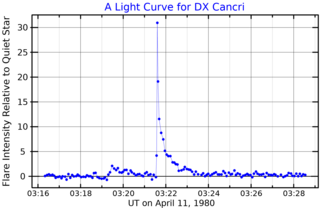
DX Cancri is a variable star in the northern zodiac constellation of Cancer. With an apparent visual magnitude of 14.81, it is much too faint to be seen with the naked eye. Visually viewing this star requires a telescope with a minimum aperture of 16 in (41 cm). Based upon parallax measurements, DX Cancri is located at a distance of 11.8 light-years from Earth. This makes it the 18th closest star to the Sun.
TZ Arietis is a red dwarf in the northern constellation of Aries. With a normal apparent visual magnitude of 12.3, it is too faint to be seen by the naked eye, although it lies relatively close to the Sun at a distance of 14.6 light-years. It is a flare star, which means it can suddenly increase in brightness for short periods of time.
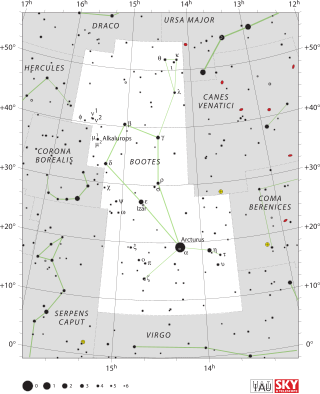
Sigma Boötis, its name Latinized from σ Boötis, is a single star in the northern constellation of Boötes. It has a yellow-white hue and is visible to the naked eye with an apparent visual magnitude of 4.46. Located to the southeast of Rho Boötis, the dwarf Sigma may at first appear as a naked-eye double, but the angular proximity with Rho is merely line-of-sight. Sigma Boötis is located at a distance of 51.1 light years from the Sun based on parallax. The star has a relatively high proper motion and is traversing the sky at the rate of 0.230″ yr−1.

Iota Cancri is a double star in the constellation Cancer approximately 300 light years from Earth.
25 Cancri is a common proper motion star system in the zodiac constellation of Cancer, located around 148 light-years away from the Sun. It has the Bayer designation d2 Cancri ; 25 Cancri is the Flamsteed designation. It is near the lower limit of visibility to the naked eye in good viewing conditions, appearing as a dim, yellow-white-hued star with a combined apparent visual magnitude of 6.11. The pair have a relatively high proper motion, traversing the celestial sphere at an angular rate of 0.245″ per year. It is moving further from the Earth with a heliocentric radial velocity of +38 km/s.
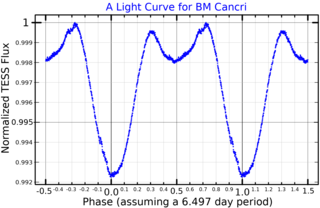
15 Cancri is an α2 CVn-type variable star in the zodiac constellation of Cancer, located around 980 light years away. It has the variable star designation BM Cancri ; 15 Cancri is the Flamsteed designation. This system is visible to the naked eye as a faint, white-hued star with an apparent visual magnitude of about 5.6. It is moving away from the Earth with a heliocentric radial velocity of 25 km/s.

38 Cancri is a variable star in the zodiac constellation Cancer, located around 607 light years from the Sun. This object has the variable star designation BT Cancri; 38 Cancri is the Flamsteed designation. It is a member of the Praesepe cluster but is a challenge to view with the naked eye, having an apparent visual magnitude of 6.65. The star is moving closer to the Earth with a heliocentric radial velocity of +32 km/s.
83 Cancri is an astrometric binary star system in the northern constellation of Cancer, positioned near the constellation border with Leo. It is a challenge to view with the naked eye, having an apparent visual magnitude of 6.61. Despite having a Flamsteed designation, the system was too faint to be included in the Bright Star Catalogue. It is located at a distance of 133 light years from the Sun, based on parallax, but is drifting closer with a radial velocity of −15 km/s. 83 Cancri has a relatively high proper motion, traversing the celestial sphere at an angular rate of 0.185″ per annum.
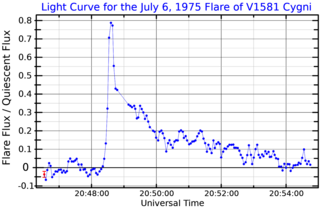
GJ 1245 is a double star with components G 208-44 and G 208-45, located 15.2 light-years away in the constellation Cygnus. G 208-44 is itself a closer double star made up of two red dwarfs, while G 208-45 is also a red dwarf. GJ 1245 is the 43rd closest stellar system to the Solar System. GJ 1245 A and B are active flare stars, and the pair are collectively designated V1581 Cygni.

11 Leonis Minoris is a binary star located 36.64 light years away from Earth, in the northern constellation of Leo Minor. It is visible to the naked eye as a dim, yellow-hued star with an apparent visual magnitude of 5.54. The system is moving away from the Earth with a heliocentric radial velocity of +14.4 km/s. It has a relatively high proper motion, traversing the celestial sphere at the rate of 0.764 arc seconds per annum.
HD 107148 is a wide binary star system in the constellation of Virgo. A pair of exoplanets have been confirmed in orbit around the brighter star. This system is located at a distance of 161 light years from the Sun based on parallax measurements, and is drifting further away with a radial velocity of 25.2 K. Although having an absolute magnitude of 4.47, at that range the system is too faint to be visible with the naked eye, having an apparent visual magnitude of 8.01.

1 Vulpeculae is a class B4IV star in the constellation Vulpecula. Its apparent magnitude is 4.77 and it is approximately 780 light years away based on parallax.

Gliese 208 is a red dwarf star with an apparent magnitude of 8.9. It is 37 light years away in the constellation of Orion. It is an extremely wide binary with 2MASS J0536+1117, an M4 star 2.6 arcminutes away
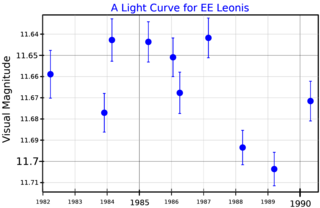
Gliese 402 is a star located 22.7 light years from the Solar System. Located in the constellation of Leo, it is also known as Wolf 358 from its entry in Max Wolf's star catalogue. The stars nearest to Gliese 402 are Gliese 393, at 3.43 light years, Gliese 408, at 6.26 light years, and Gliese 382 at 6.66 light years.

VZ Cancri is a variable star in the constellation Cancer, abbreviated VZ Cnc. It varies in brightness with a period of 0.178364 days, from an apparent visual magnitude of 7.18 down to 7.91, which lies below the typical threshold of visibility for the naked eye. The distance to this star is approximately 724 light years based on parallax measurements, and it is receding from the Sun with a radial velocity of 25 km/s.
References
- ↑ Final Results of NameExoWorlds Public Vote Released
- ↑ Abt, Helmut A. (2004). "Spectral Classification of Stars in A Supplement to the Bright Star Catalogue". The Astrophysical Journal Supplement Series. 155 (1): 175–177. Bibcode:2004ApJS..155..175A. doi: 10.1086/423803 .
- 1 2 van Leeuwen, F. (November 2007). "Validation of the new Hipparcos reduction". Astronomy & Astrophysics . 474 (2): 653–664. arXiv: 0708.1752 . Bibcode:2007A&A...474..653V. doi:10.1051/0004-6361:20078357. S2CID 18759600.
- ↑ Bidelman, William P.; Ratcliff, Stephen J.; Svolopoulos, Sotirios (1988). "Spectral types of 80 early-type stars of variable radial velocity". Astronomical Society of the Pacific. 100: 828. Bibcode:1988PASP..100..828B. doi: 10.1086/132242 .
- ↑ "44 Cancri - HD74200 - HIP42791". Universe Guide. 25 January 2015. Retrieved 24 September 2017.
- ↑ SIMBAD, 44 Cancri (Retrieved 24 September 2017)
- ↑ Jenkins, J. S.; Ramsey, L. W.; Jones, H. R. A.; Pavlenko, Y.; Gallardo, J.; Barnes, J. R.; Pinfield, D. J. (2009). "Rotational Velocities for M Dwarfs". The Astrophysical Journal . 704 (2): 975–988. arXiv: 0908.4092 . Bibcode:2009ApJ...704..975J. doi:10.1088/0004-637X/704/2/975. S2CID 119203469.
- ↑ Dittmann, Jason A.; Irwin, Jonathan M.; Charbonneau, David; Berta-Thompson, Zachory K. (2014). "Trigonometric Parallaxes for 1507 Nearby Mid-to-late M Dwarfs". The Astrophysical Journal. 784 (2): 156. arXiv: 1312.3241 . Bibcode:2014ApJ...784..156D. doi:10.1088/0004-637X/784/2/156. S2CID 18789867.
- ↑ Lépine, Sébastien (2013). "A Spectroscopic Catalog of the Brightest (J < 9) M Dwarfs in the Northern Sky". The Astronomical Journal. 145 (4): 102. arXiv: 1206.5991 . Bibcode:2013AJ....145..102L. doi:10.1088/0004-6256/145/4/102. S2CID 117144290.
- 1 2 Cutri, R. M.; et al. (2003). "2MASS All-Sky Catalog of Point Sources". VizieR On-line Data Catalog. Bibcode:2003yCat.2246....0C.
- ↑ Wilson, Ralph Elmer (1953). "General catalogue of stellar radial velocities". Carnegie Institute Washington D.C. Publication. Bibcode:1953GCRV..C......0W.
- ↑ Zacharias, N. (2012). "The fourth US Naval Observatory CCD Astrograph Catalog (UCAC4)". VizieR On-line Data Catalog. Bibcode:2012yCat.1322....0Z.
- ↑ Alonso-Floriano, F. J.; Morales, J. C.; Caballero, J. A.; Montes, D.; Klutsch, A.; Mundt, R.; Cortés-Contreras, M.; Ribas, I.; Reiners, Ansgar; Amado, P. J.; Quirrenbach, A.; Jeffers, S. V. (2015). "CARMENES input catalogue of M dwarfs" (PDF). Astronomy & Astrophysics. 577: A128. arXiv: 1502.07580 . doi:10.1051/0004-6361/201525803. S2CID 53135130.
- ↑ Lépine, Sébastien; Shara, Michael M. (2005). "A Catalog of Northern Stars with Annual Proper Motions Larger than 0."15 (LSPM-NORTH Catalog)". The Astronomical Journal. 129 (3): 1483–1522. arXiv: astro-ph/0412070 . Bibcode:2005AJ....129.1483L. doi:10.1086/427854. S2CID 2603568.
- ↑ "LHS 2090". SIMBAD . Centre de données astronomiques de Strasbourg . Retrieved 29 January 2018.
- ↑ Henry, T. J.; Jao, Wei-Chun; Subasavage, John P.; Beaulieu, Thomas D.; Ianna, Philip A.; Costa, Edgardo; Méndez, René A. (2006). "The Solar Neighborhood. XVII. Parallax Results from the CTIOPI 0.9 m Program: 20 New Members of the RECONS 10 Parsec Sample" (PDF). The Astronomical Journal . 132 (6): 2360–2371. arXiv: astro-ph/0608230 . Bibcode:2006AJ....132.2360H. doi:10.1086/508233. S2CID 15002841.
{{cite journal}}: CS1 maint: multiple names: authors list (link)